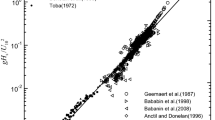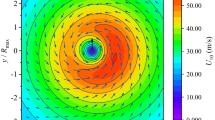Abstract
Wind stress is an important driving force for many meteorological and oceanographical processes. However, most of the existing methods for evaluation of the wind stress, including various bulk formulas in terms of the wind speed at a given height and formulas relating the roughness height of the sea surface with wind conditions, predict an ever-increasing tendency of the wind stress coefficient as the wind speed increases, which is inconsistent with the field observations under storm conditions. The wave boundary layer model, which is based on the momentum and energy conservation, has the advantage to take into account the physical details of the air–sea interaction process, but is still invalid under storm conditions without a modification. By including the energy dissipation due to the presence of sea spray, which is speculated to be an important aspect of the air–sea interaction under storm conditions, the wave boundary layer model is improved in this study. The improved model is employed to estimate the wind stress caused by an idealized tropical cyclone motion. The computational results show that the wind stress coefficient reaches its maximal value at a wind speed of about 40 m/s and decreases as the wind speed further increases. This is in fairly good agreement with the field data.







Similar content being viewed by others
References
Andreas EL (1998) A new sea spray generation function for wind speeds up to 32 m s−1. J Phys Oceanogr 28(11):2175–2184
Andreas EL (2004) Spray stress revisited. J Phys Oceanogr 34(6):1429–1440
Andreas EL, DeCosmo J (1999) Sea spray production and influence on air–sea heat and moisture fluxes over the open ocean. In: Geernaert GL (ed) Air–sea exchange: physics, chemistry and dynamics. Kluwer, Amsterdam, pp 327–362
Bao JW, Fairall CW, Michelson SA, Bianco L (2011) Parameterizations of sea–spray impact on the air–sea momentum and heat fluxes. Mon Weather Rev 139(12):3781–3797
Bunya S, Dietrich JC, Westerink JJ, Ebersole BA, Smith JM, Atkinson JH, Jensen R, Resio DT, Luettich RA, Dawson C, Cardone VJ, Cox AT, Powell MD, Westerink HJ, Roberts HJ (2010) A high-resolution coupled riverine flow, tide, wind, wind wave, and storm surge model for Southern Louisiana and Mississippi. Part I: model development and validation. Mon Weather Rev 138(2):345–377
Charnock H (1955) Wind stress on a water surface. QJR Meteorol Soc 81(350):639–640
Chen C, Liu H, Beardsley RC (2003) An unstructured grid, finite-volume, three-dimensional, primitive equations ocean model: application to coastal ocean and estuaries. J Atmos Ocean Technol 20(1):159–186
Donelan MA, Dobson FW, Smith SD, Anderson RJ (1993) On the dependence of sea surface roughness on wave development. J Phys Oceanogr 23(9):2143–2149
Donelan MA, Haus BK, Reul N, Plant WJ, Stiassnie M, Graber HC, Brown OB, Saltzman ES (2004) On the limiting aerodynamic roughness of the ocean in very strong winds. Geophys Res Lett 31:L18306
Drennan WM, Graber HC, Hauser D, Quentin C (2003) On the wave age dependence of wind stress over pure wind seas. J Geophys Res Oceans 108(C3):8062
Edson JB, Anquentin S, Mestayer PG, Sini JF (1996) Spray droplet modeling: 2. An interactive Eulerian–Lagrangian model of evaporating spray droplets. J Geophys Res 101(C1):1279–1293
Emanuel KA (1995) Sensitivity of tropical cyclones to surface exchange coefficients and a revised steady-state model incorporating eye dynamics. J Atmos Sci 52(22):3969–3976
Fairall CW, Banner ML, Peirson WL, Asher W, Morison RP (2009) Investigation of the physical scaling of sea spray spume droplet production. J Geophys Res 114:C10001
Garratt JR (1977) Review of drag coefficients over oceans and continents. Mon Weather Rev 105(7):915–929
Hara T, Belcher SE (2002) Wind forcing in the equilibrium range of wind-wave spectra. J Fluid Mech 470:223–245
Hara T, Belcher SE (2004) Wind profile and drag coefficient over mature ocean surface wave spectra. J Phys Oceanogr 34(11):2345–2358
Holland GJ (1980) An analytical model of the wind and pressure profiles in hurricanes. Mon Weather Rev 108:1212–1218
Holthuijsen LH, Powell MD, Pietrzak JD (2012) Wind and waves in extreme hurricanes. J Geophys Res Oceans 117:C09003
Janssen PAEM (1989) Wind-induced stress and the drag of air-flow over sea waves. J Phys Oceanogr 19:745–754
Janssen PAEM (1991) Quasi-linear theory of wind-wave generation applied to wave forecasting. J Phys Oceanogr 21:1631–1642
Jarosz E, Mitchell DA, Wang DW, Teague WJ (2007) Bottom–up determination of air–sea momentum exchange under a major tropical cyclone. Science 315(5819):1707–1709
Kudryavtsev VN (2006) On the effect of sea drops on the atmospheric boundary layer. J Geophys Res 111:C07020
Kudryavtsev VN, Makin VK (2001) The impact of air-flow separation on the drag of the sea surface. Bound Layer Meteorol 98(1):155–171
Kudryavtsev VN, Makin VK (2007) Aerodynamic roughness of the sea surface at high winds. Bound Layer Meteorol 125(2):289–303
Kudryavtsev VN, Makin VK (2011) Impact of ocean spray on the dynamics of the marine atmospheric boundary layer. Bound Layer Meteorol 140(3):383–410
Large WG, Pond S (1981) Open ocean momentum flux measurements in moderate to strong winds. J Phys Oceanogr 11(3):324–336
Makin VK (2005) A note on the drag of the sea surface at hurricane winds. Bound Layer Meteorol 115(1):169–176
Makin VK, Kudryavtsev VN (1999) Coupled sea surface-atmosphere model: 1. Wind over waves coupling. J Geophys Res Oceans 104(C4):7613–7623
Makin VK, Kudryavtsev VN (2002) Impact of dominant waves on sea drag. Bound Layer Meteorol 103(1):83–99
Miles JW (1957) On the generation of surface waves by shear flows. J Fluid Mech 3(02):185–204
Moon I, Ginis I, Hara T (2004a) Effect of surface waves on air-sea momentum exchange: II. Behavior of drag coefficient under tropical cyclones. J Atmos Sci 61(19):2334–2348
Moon I, Hara T, Ginis I, Belcher SE, Tolman HL (2004b) Effect of surface waves on air-sea momentum exchange: I. Effect of mature and growing seas. J Atmos Sci 61(19):2321–2333
Plant WJ (1982) A relationship between wind stress and wave slope. J Geophys Res Oceans 87(NC3):1961–1967
Powell MD, Vickery PJ, Reinhold TA (2003) Reduced drag coefficient for high wind speeds in tropical cyclones. Nature 422(6929):279–283
Qi JH, Chen CS, Beardsley RC, Perrie W, Cowles GW, Lai ZG (2009) An unstructured-grid finite-volume surface wave model (FVCOM-SWAVE): implementation, validations and applications. Ocean Model 28(1–3):153–166
Rastigejev Y, Suslov SA, Lin Y (2011) Effect of ocean spray on vertical momentum transport under high-wind conditions. Bound Layer Meteorol 141(1):1–20
Reichl BG, Hara T, Ginis I (2014) Sea state dependence of the wind stress over the ocean under hurricane winds. J Geophys Res Oceans 119(1):30–51
Richter DH, Sullivan PP (2013) Sea surface drag and the role of spray. Geophys Res Lett 40(3):656–660
Taylor PK, Yelland MJ (2001) The dependence of sea surface roughness on the height and steepness of the waves. J Phys Oceanogr 31(2):572–590
Veron F, Hopkins C, Harrison EL, Mueller JA (2012) Sea spray spume droplet production in high wind speeds. Geophys Res Lett 39:L16602
Wu J (1982) Wind-stress coefficients over sea surface from breeze to hurricane. J Geophys Res 87(C12):9704–9706
Zijlema M, van Vledder GP, Holthuijsen LH (2012) Bottom friction and wind drag for wave models. Coast Eng 65:19–26
Acknowledgments
This study is financially supported by State Key Laboratory of Hydroscience and Engineering, China, under grant No. 2014-KY-02 and by National Natural Science Foundation of China (NSFC) under grant No. 11472156. The authors would also like to thank Professor Changsheng Chen and the Marine Ecosystem Dynamics Modeling Laboratory at University of Massachusetts-Dartmouth for making the FVCOM code publically available.
Author information
Authors and Affiliations
Corresponding author
Rights and permissions
About this article
Cite this article
Chen, Y., Yu, X. Enhancement of wind stress evaluation method under storm conditions. Clim Dyn 47, 3833–3843 (2016). https://doi.org/10.1007/s00382-016-3044-4
Received:
Accepted:
Published:
Issue Date:
DOI: https://doi.org/10.1007/s00382-016-3044-4




